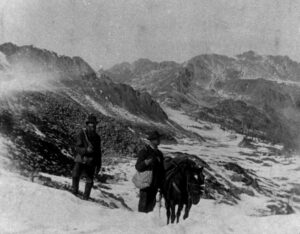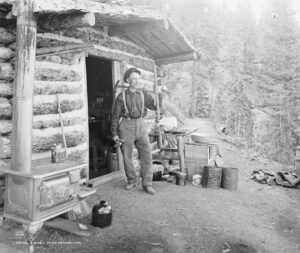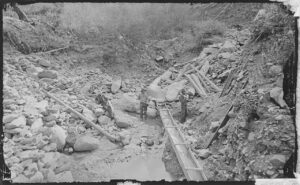 When we think of the Gold Rush years, most of us think of California, but in reality, not every big strike was in California. One of the greatest gold rushes of North America occurred in the Pike’s Peak area. Known as the Pike’s Peak Gold Rush, it was also called the Colorado Gold Rush. The Pike’s Peak Gold Rush a boom in gold prospecting and mining in the Pike’s Peak area of what was then the western Kansas Territory and southwestern Nebraska Territory of the United States. Now it is located in Colorado, of course. The rush began in July 1858 and lasted until just about the time of the creation of the Colorado Territory on February 28, 1861. The rush brought an estimated 100,000 gold seekers, called the Fifty-Niners to the Pike’s Peak area. It was part of one of the greatest gold rushes in North American history.
When we think of the Gold Rush years, most of us think of California, but in reality, not every big strike was in California. One of the greatest gold rushes of North America occurred in the Pike’s Peak area. Known as the Pike’s Peak Gold Rush, it was also called the Colorado Gold Rush. The Pike’s Peak Gold Rush a boom in gold prospecting and mining in the Pike’s Peak area of what was then the western Kansas Territory and southwestern Nebraska Territory of the United States. Now it is located in Colorado, of course. The rush began in July 1858 and lasted until just about the time of the creation of the Colorado Territory on February 28, 1861. The rush brought an estimated 100,000 gold seekers, called the Fifty-Niners to the Pike’s Peak area. It was part of one of the greatest gold rushes in North American history.
The peak year for the gold rush was 1859, and so after that year, the miners were called Fifty-Niners. The miners often used the motto “Pike’s Peak or Bust!” Actually, the location of the Pike’s Peak Gold Rush was centered 85 miles north of Pike’s Peak, but because of the well-known mountain, and its visibility from a long way off, the name of the peak became the name of the rush. The Pike’s Peak Gold Rush, began about a decade after the California Gold Rush, and produced a dramatic, albeit temporary influx of migrants and immigrants into the Pike’s Peak Country of the Southern Rocky Mountains. When the rush ended many of them moved on to other placed in search o the next big rush. The prospectors provided the first major European-American population in the region. The rush brought with it a few mining camps such as Denver City and Boulder City that would actually develop into cities that still exist today. Many smaller camps such as Auraria and Saint Charles City were among those that were later absorbed by larger camps and towns. Still others, faded into ghost towns, but quite a few camps such as Central City, Black Hawk, Georgetown, and Idaho Springs survived.
The discovery of gold in the Pike’s Peak area wasn’t a surprise to everyone. In 1835, French trapper Eustace Carriere lost his party and ended up wandering through the mountains for many weeks. During those weeks he  found many gold specimens which he later took back to New Mexico for examination. I suppose it was worth being lost, but while the specimens turned out to be “pure gold” he was unable to locate the area on an expedition he led to go back and look for it. He just couldn’t quite remember the location. Also, in 1849 and 1850, several parties of gold seekers bound for the California Gold Rush panned small amounts of gold from various streams in the South Platte River valley at the foot of the Rocky Mountains. They decided that they weren’t really impressed with the Rocky Mountain gold, so they moved on to California, possibly cheating themselves out of a great find, had the persevered.
found many gold specimens which he later took back to New Mexico for examination. I suppose it was worth being lost, but while the specimens turned out to be “pure gold” he was unable to locate the area on an expedition he led to go back and look for it. He just couldn’t quite remember the location. Also, in 1849 and 1850, several parties of gold seekers bound for the California Gold Rush panned small amounts of gold from various streams in the South Platte River valley at the foot of the Rocky Mountains. They decided that they weren’t really impressed with the Rocky Mountain gold, so they moved on to California, possibly cheating themselves out of a great find, had the persevered.
When the California Gold Rush began to die out, many discouraged gold seekers started to return home. Still, they weren’t really wanting to go home empty-handed, and they has heard the rumors of gold in the Pike’s Peak area. So, they tried their luck again, and their hard work paid off. In the summer of 1857, a party of Spanish-speaking gold seekers from New Mexico worked a placer deposit along the South Platte River about 5 miles above Cherry Creek, now part of metropolitan Denver.
William Greeneberry “Green” Russell was a Georgian man who had worked in the California gold fields in the 1850s. He was married to a Cherokee woman, and through his connections to the tribe, he heard about an 1849 discovery of gold along the South Platte River. Much encouraged, he organized a party to prospect along the South Platte River. He set out with his two brothers and six companions in February 1858. They met up with Cherokee tribe members along the Arkansas River in present-day Oklahoma and continued westward along the Santa Fe Trail. Others joined the party along the way until their number reached 107 people.
When you have spent any time in Colorado, the names of the places where gold was found are very real to you. Places like Cherry Creek, Denver, Confluence Park in Denver, Englewood, and a number of others stand out to you. The group finally found a small amount of 20 troy ounces in the Englewood area. Their excitement grew… and so the boom began. The first decade of the boom was largely concentrated along the South Platte River at the base of the Rocky Mountains, in the canyon of Clear Creek in the mountains west of Golden City, at Breckenridge and in South Park at Como, Fairplay, and Alma. The towns of Denver City, Golden City, and Boulder City were substantial towns that served the mines in 1860. It was the rapid population growth of the Pike’s Peak Gold Rush that led to the creation of the Colorado Territory in 1861. Unfortunately, the rush, like all gold rushes, faded and while Colorado is still a fairly large population area, it isn’t what it might have been had the gold rush continued.
and so the boom began. The first decade of the boom was largely concentrated along the South Platte River at the base of the Rocky Mountains, in the canyon of Clear Creek in the mountains west of Golden City, at Breckenridge and in South Park at Como, Fairplay, and Alma. The towns of Denver City, Golden City, and Boulder City were substantial towns that served the mines in 1860. It was the rapid population growth of the Pike’s Peak Gold Rush that led to the creation of the Colorado Territory in 1861. Unfortunately, the rush, like all gold rushes, faded and while Colorado is still a fairly large population area, it isn’t what it might have been had the gold rush continued.


Leave a Reply